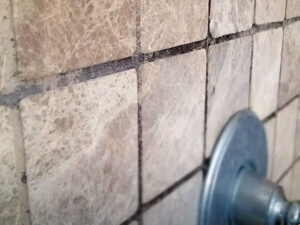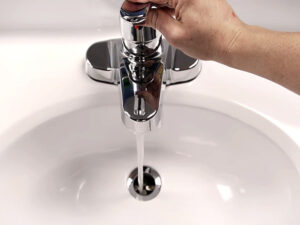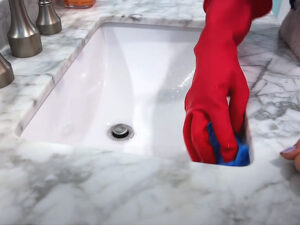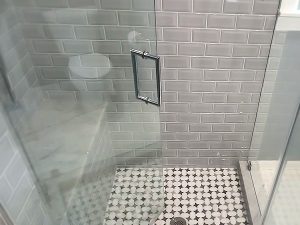Have you ever walked into your bathroom and seen a dull, hazy layer on the floor where it used to be clean? Soap scum is a problem that many of us have to deal with all the time. Over time, this ugly residue can build up, making the floor of your bathroom look dirty and unclean. I’ve been in that situation, so I know how frustrating it can be.
In my drive for a spotless bathroom, I’ve tried a lot of different ways to get rid of soap scum. Today, I’d like to share with you some of the best methods that have worked for me. I’ve tried everything from natural treatments to store-bought cleaners, and I’m excited to share what I’ve learned to help you make your bathroom floor shine again.
In this blog post, I’ll show you step-by-step how to clean soap scum off the floor of your bathroom. I’ve got you covered whether you have a tiled, vinyl, or flooring surface. Say goodbye to dirty, dull floors and hello to a sparkling bathroom.
Understanding Soap Scum
Soap scum is a regular problem in bathrooms that many people have to deal with. It’s a sticky substance that builds up on bathroom floors, especially where water splashes and mixes with soap residue. Soap scum is made up of bits of soap, mineral deposits, body oils, and dead skin cells that build up over time.
Hard water, which has a lot of minerals like calcium and magnesium, is a big reason why soap scum builds up. When hard water and soap mix, they make chemicals that don’t dissolve and stick to surfaces, like bathroom floors. Soap scum not only makes the floor look bad, but it can also make the room dirty because it can hold germs and fungi.
To get rid of soap scum, you need to know what it is made of and choose the right way to clean it. Different types of flooring may react differently to cleaning products, so it’s important to think about the floor’s material when choosing a cleaner. Also, the amount of soap scum buildup may affect the choice of cleaning method, such as whether to use a sponge or a scrub brush for a more thorough job.
By knowing how soap scum forms and what causes it to build up, homes can effectively deal with this problem and keep their bathroom floors clean and healthy.
What Makes Soap Scum Build Up on the Floor of the Bathroom?
Soap scum is a common problem on bathroom floors that can be caused by a number of things. To prevent and get rid of soap scum successfully, you need to know what causes it. Here are the most important things that lead to soap scum:
Soap Residue: Soap has fatty acids and oils that don’t dissolve fully in water. When soap is used in the shower or to wash your hands, it leaves behind a thin film of soap on bathroom surfaces, including the floor. Over time, this material builds up and gets harder, turning into soap scum.
Hard Water: Water that is hard has a lot of minerals in it, like calcium and magnesium. When soap meets hard water, the two combine to make compounds that can’t be dissolved in water. When these chemicals are mixed with soap waste, they make a sticky film that sticks to the bathroom floor and other surfaces. Hard water can make soap scum build up worse, which makes it harder to get rid of.
Moisture and Humidity: Bathrooms are naturally wet places where people often come into contact with water. Soap scum can form on bathroom floors where there is a lot of moisture, like from water splashes or high humidity. As the water disappears, it leaves behind the leftover soap, which builds up and gets harder over time.
Lack of Regular Cleaning: Soap residue and soap scum can build up if the bathroom isn’t cleaned well or often enough. Without regular cleaning, the soap residue on the floor can build up and turn into a thick layer of soap scum that is hard to get rid of.
To get rid of soap scum, it is important to deal with these reasons. Soap scum on the floor and other surfaces can be kept to a minimum by cleaning regularly, using the right cleaning methods and products, and controlling the amount of wetness in the bathroom. By knowing what causes it, homes can take steps to stop soap scum from building up and keep their bathrooms clean and healthy.
Steps to Get Soap Scum Off Your Bathroom Floor
It can be tough to keep a bathroom clean and free of soap scum. Soap scum is a layer that is left behind when soap mixes with minerals in hard water and other dirt. It can build up on different surfaces, like bathroom floors, and leave a film that looks bad and is hard to walk on. With the right strategy and a few easy steps, you can get rid of soap scum from your bathroom floor. Now, I’ll walk you through the process step by step. I’ll do this under eight subheadings.

Get the materials you need
Before you start getting rid of soap scum, you need to make sure you have everything you need. This will save you time and make sure you have all the things you need. Some of the most popular things you will need are:
- Warm water in a bucket
- White vinegar
- Baking soda
- A brush or sponge for cleaning
- Rubber gloves
- A cleaning cloth made of microfiber or cotton
- Mild liquid soap or dish cleaner
Getting the floor ready
First, pick up any loose items or trash from the bathroom floor. This includes bath mats, rugs, and anything else that might make it hard to clean. Once the floor is clear, quickly sweep or vacuum it to get rid of any dust, hair, or bigger pieces. This will help you see the soap scum better.
Using vinegar as a measure
Vinegar is a natural cleaner that works well and can get rid of soap scum. In a bucket, mix equal amounts of white vinegar and warm water. Put on your rubber gloves to keep the acidity of the vinegar from hurting your hands. You can use a clean brush or sponge to apply the vinegar solution to the soap scum on the floor. Let the mix sit for a few minutes so the vinegar can break down the scum.
Getting rid of the soap scum
After letting the vinegar solution sit, scrub the soap scum hard with the scrub brush or sponge. Use strong pressure and move your hands in small circles. Pay attention to the places where the soap scum is thickest. If you need to, you can keep the brush or sponge wet while you scrub by dipping it back into the vinegar solution. Scrub until you’ve gotten rid of as much soap scum as you can.
Using baking soda as a light abrasive
Baking soda is another great natural cleaner that can help get rid of soap scum that is hard to get rid of. Sprinkle a lot of baking soda directly on the floor, paying special attention to spots with a lot of soap scum. Scrub the baking soda into the floor with a wet sponge or cloth. Baking soda is a gentle abrasive that helps break up soap scum without causing damage to the surface. Keep scrubbing until the soap scum is gone and can be seen.
Cleaning up the floor
Once you’ve used vinegar and baking soda to scrub away the soap scum, it’s time to rinse the floor well. Fill a clean bucket with warm water and wipe the floor with a clean cloth or sponge. Rinse the cloth or sponge in the bucket often to get rid of any leftovers. Repeat this step until there is no more vinegar, baking soda, or soap scum left.
Getting the floor dry
It’s important to dry the bathroom floor after washing it so that no one slips or falls. Pat the floor dry with a clean microfiber or cotton cloth. Make sure to pay attention to corners, edges, and other places where water might pool. Let the floor dry completely on its own before putting rugs or bath mats back on it.
Preventing future soap scum buildup
Set up a regular cleaning schedule if you don’t want soap scum to build up on your bathroom floor in the future. At least once a week, clean the floor with a weak liquid soap or dish detergent diluted in warm water. Clean up any soap or other bath goods that get dropped right away. Also, think about using a squeegee or a towel to get rid of any extra water after every shower or bath.
In conclusion, you can get rid of soap scum from a bathroom floor by doing these simple things. You can keep your bathroom floor clean and free of soap scum by getting the right tools, preparing the floor, cleaning it with vinegar and baking soda, rinsing and drying it properly, and taking preventative steps. Keeping up with upkeep will help keep your bathroom clean and inviting.
Alternative Methods to Remove Soap Scum from Your Bathroom Floor
Even though vinegar and baking soda are the usual way to get rid of soap scum on a bathroom floor, there are other ways to do it. To get rid of soap scum that won’t go away, these ways may use different cleaning products or methods. Below, we look at a few different ways to help you get rid of soap scum on your bathroom floor.
Salt and Lemon Juice
Lemon juice has acids in it that can break down soap scum, and salt can be used as a light scrubber. To use this method, squeeze fresh lemon juice onto the soap scum and then add salt on top of it. Let the mixture sit for a few minutes, and then use a brush or sponge to scrub the area. After that, rinse the floor well with warm water.
Commercial products to remove soap scum
There are soap scum removers that you can buy if you prefer to use commercial cleaning tools. These items are made to dissolve and get rid of soap scum that doesn’t want to go away. If you want the best results, follow the directions on the package. Wear gloves and make sure there is enough airflow when you use these chemical-based cleaners.
Cleaning by steam
Cleaning with steam can be a good way to get soap scum off of bathroom floors. Dirt and grime are broken up by steam cleaners with hot steam. Follow the instructions for how to use the steam cleaner and focus on the areas with soap scum. The steam’s heat and wetness will loosen and break up the soap scum, making it easier to wipe away.
Solution of ammonia
Ammonia is an alkaline cleaner that is strong enough to cut through soap scum. Ammonia and water should be mixed in a place with good airflow. Wear gloves and apply the ammonia solution to the soap scum with a sponge or a cloth. After a few minutes, use a brush to clean the area. Rinse the floor well with water, and make sure there is enough airflow while and after using ammonia.
Hydrogen Peroxide
Hydrogen peroxide can also be a good way to get rid of soap scum. Pour hydrogen peroxide right on the soap scum and let it sit for a few minutes. The peroxide will help break up the soap scum, making it easy to scrub away. Scrub the area with a brush or sponge, then rinse the floor well with water.
Magic Eraser
Magic Erasers are cleaning tools that have tiny pieces of sand in them. Wet the Magic Eraser and scrub the soap scum on the floor of the bathroom gently. The rough particles help lift and remove the soap scum without hurting the surface. After using the Magic Eraser, rinse the floor well to get rid of any residue.
Enzymes that clean
Another way to get rid of soap scum is to use enzyme cleaners. These cleaners have enzymes that work well to break down organic matter, like soap scum. Use the enzyme cleaner on the soap scum by following the directions on the product. Let it sit for as long as it says, then scrub the area and wash it well.
Make sure to test any alternative way on a small, unnoticeable part of your bathroom floor before using it all over. This will help make sure that the cleaner or cleaning method doesn’t hurt or change the color of the item. Choose the method that works best for you and fits the type of flooring in your bathroom. With patience and the right method, you can get rid of soap scum and keep your bathroom floor clean and shiny.
Preventing Future Soap Scum from Your Bathroom Floor
To keep a bathroom clean and healthy, it’s important to stop soap scum from building up. By being cautious and taking a few preventive steps, you can cut down on the amount of soap scum on your bathroom floor by a large amount. Here are some good ways to avoid getting soap scum in the future:
Routines for cleaning
The best way to stop soap scum from building up is to clean on a regular schedule. Make a plan to sweep or vacuum the bathroom floor on a regular basis to get rid of loose dirt and waste. Also, clean the floor at least once a week with a wet cloth or mop to get rid of any soap residue or water splashes before they can harden into soap scum.
Quick Clean-Ups
In addition to regular cleaning, a quick wipe down after each shower or bath can help keep soap scum from building up. Keep a squeegee or a microfiber cloth nearby and quickly wipe away any water drops or soap residue from the floor and walls. This easy step can do a lot to stop soap scum from building up.
Use mild cleaners with a neutral pH
Instead of harsh chemicals, choose soft, pH-neutral cleaners to clean the floor of your bathroom. Harsh cleaners can remove the floor’s protective layers, making it more likely to get soap scum. Look for cleaners that are made for your type of flooring, and avoid scrubbing pads that are too rough and could scratch the surface.
Proper Ventilation
Proper airflow is very important to stop soap scum and keep the bathroom from getting too damp. After taking a shower or bath, open a window or turn on a vent fan to get rid of extra moisture. Ventilation helps the floor dry faster, which makes it less likely that soap scum will form.
Get the Floor Dry
Make sure to dry the bathroom floor well after cleaning or when water gets on it. Soap scum is more likely to form on surfaces that are still damp, so use a towel or a mop to get rid of any extra water. Look out for corners and hard-to-reach spots where water likes to gather.
Put a water softener in place
If you live in a place where the water is hard, you might want to get a water filter. Minerals in hard water make it easier for soap scum to build up. A water softener gets rid of these minerals, which makes it less likely that soap scum will build up on bathroom surfaces. You can also add pure white vinegar to your mop water or use it as a final rinse after cleaning to soften the water naturally.
Use dishes or dispensers for the soap
Instead of putting bars of soap directly on the floor or table, use soap dishes or dispensers. This will keep soap residue from building up on the floor. Soap dishes or pitchers raise the soap, which lets water drain away and makes it less likely that soap scum will form.
Use bath mats or shower curtains.
Using bathroom curtains or bath mats is another way to keep them out. With these accessories, the water stays in the bathing area and doesn’t get all over the toilet floor. Bath mats also soak up water, so less of it gets on the floor and there is less chance of soap scum building up.
By taking these preventive steps, you can cut down on the amount of soap scum on your bathroom floor by a lot. To keep soap scum from becoming a long-term problem, you need to be consistent and do regular upkeep. Make sure to adapt these tips to the type of floors you have and use them every time you clean your bathroom. With a little work, you can have a clean bathroom floor without soap scum.
FAQs
Can hydrogen peroxide really get soap scum off the floor of a bathroom?
Yes, hydrogen peroxide can be used to clean a bathroom floor and get rid of soap scum. It is slightly acidic, which helps break down the soap residue. To use hydrogen peroxide, put the same amount of water and hydrogen peroxide in a spray bottle. Spray the solution on the soap scum and wait a few minutes to let it soak in. Then, scrub the area with a soft brush or sponge and wash it well with water. Hydrogen peroxide works well on soap scum spots that are hard to get rid of.
Can I use a squeegee to keep my bathroom floor from getting soap scum on it?
Absolutely! Using a squeegee after each shower or bath can help keep soap scum from building up on the floor of your toilet. Run the squeegee across the floor after taking a bath to get rid of any water and soap left behind. Soap scum doesn’t form because the water doesn’t dry out. Make sure to clean the squeegee after every use so that soap scum doesn’t get transferred to other places.
Can different types of bathroom floors be cleaned of soap scum with a steam cleaner?
Yes, steam cleaners can effectively get rid of soap scum from all kinds of bathroom floors. High-temperature steam is used to break up and remove soap scum, which makes it easier to wipe off. But it’s important to check the manufacturer’s instructions and see if steam cleaning is right for the type of flooring you have. For example, cleaning ceramic or porcelain tile floors with steam is usually safe, but it may not be a good idea for concrete or wood floors.
Can a mixture of baking soda and hydrogen peroxide help get soap scum off the floor of a bathroom?
Yes, mixing baking soda and hydrogen peroxide can be a good way to get rid of hard soap scum on a bathroom floor. Mix baking soda and hydrogen peroxide together until you get a paste with a thick consistency. Apply the paste straight to the soap scum and let it sit for about 15 to 20 minutes to let the mixture loosen the residue. Then, scrub the area with a brush or sponge and rinse it with water. Baking soda acts as a gentle scrubber, and hydrogen peroxide helps break up the soap scum.
Can a mixture of vinegar and dish soap be used to clean soap scum off the floor of a bathroom?
Yes, a mixture of vinegar and dish soap can be used to clean soap scum off the floor of a bathroom. In a spray bottle, mix equal parts of white vinegar and dish soap. Then, spray the mixture on the soap scum. Let it sit for a few minutes so the acidic qualities of the vinegar can break down the residue. Use a brush or sponge to scrub the area, and then rinse it well with water. Vinegar is a natural acid that helps get rid of soap scum. The dish soap helps get rid of greasy leftovers.
Can a stiff-bristled scrub brush make it easier to get soap scum off rough bathroom floors?
Using a scrub brush with stiff bristles can make it easier to get soap scum off textured bathroom floors. Soap scum can build up on uneven surfaces and in cracks, but the brushes can get into those places and get rid of it. But make sure to pick a brush with soft bristles so you don’t scratch or damage the flooring material. First, try the brush on a small, hidden area to make sure it doesn’t hurt.
Can using a neutral pH floor cleaner on a daily basis keep soap scum from building up on a bathroom floor?
Yes, a pH-neutral floor cleaner can help keep soap scum from building up on a bathroom floor if it is used regularly. pH-neutral cleaners are made to be gentle on different kinds of floors while still getting rid of dirt and soap residue. By cleaning the floor often with a neutral pH cleaner, you can keep it clean and stop soap scum from building up. For the best results, follow the directions on the bottle of cleaner.
Can rubbing alcohol be used to get rid of soap scum on the floor of a bathroom?
Yes, you can use rubbing alcohol to get rid of soap scum on a bathroom floor. Apply a small amount of rubbing alcohol straight to the soap scum and let it sit for a few minutes to dissolve the residue. Then, scrub the area gently with a brush or sponge and rinse it with water. As a lubricant, rubbing alcohol helps break up the soap scum, making it easier to get rid of. But you should test the rubbing alcohol on a small, unnoticeable part of the floor first to make sure it doesn’t stain or damage the floor.
Can a blend of white vinegar and essential oils be used to clean the bathroom floor and make it smell nice?
Yes, a blend of white vinegar and essential oils can be used to clean the bathroom floor and make it smell nice. In a spray bottle, mix one part white vinegar with two parts water. Add a few drops of your favorite essential oil to make it smell good. Spray the solution on the soap scum, let it sit for a few minutes, then scrub and rinse. The essential oil will help cover up the smell of vinegar, leaving behind a fresh scent.
Can sealing or cleaning the bathroom floor make it easier to clean and stop soap scum from building up?
Yes, sealing or cleaning the bathroom floor can help keep soap scum from building up and make it easier to clean. By putting a sealant or wax on the floor’s surface, you make it less likely to get stained by soap scum and other things. Sealant or wax also makes it easier to wipe away soap residue and keeps it from sticking to the floor. Follow the directions that come with the sealant or wax you choose for how to use it and how to keep it in good shape.
Final Thoughts
To get rid of soap scum from a bathroom floor, you need to know how to clean it properly and take preventative steps. By knowing what causes soap scum to build up, homes can take steps to stop it from happening and keep their bathrooms clean. Regular cleaning, using light cleaners, making sure the room has enough airflow, and drying the floor completely are all good ideas. Using soap dishes, shower curtains, and bath mats can also help keep soap scum from building up. By using these tips and being proactive about cleaning, you can keep soap scum off the floor of your bathroom and enjoy a clean, shiny space.







